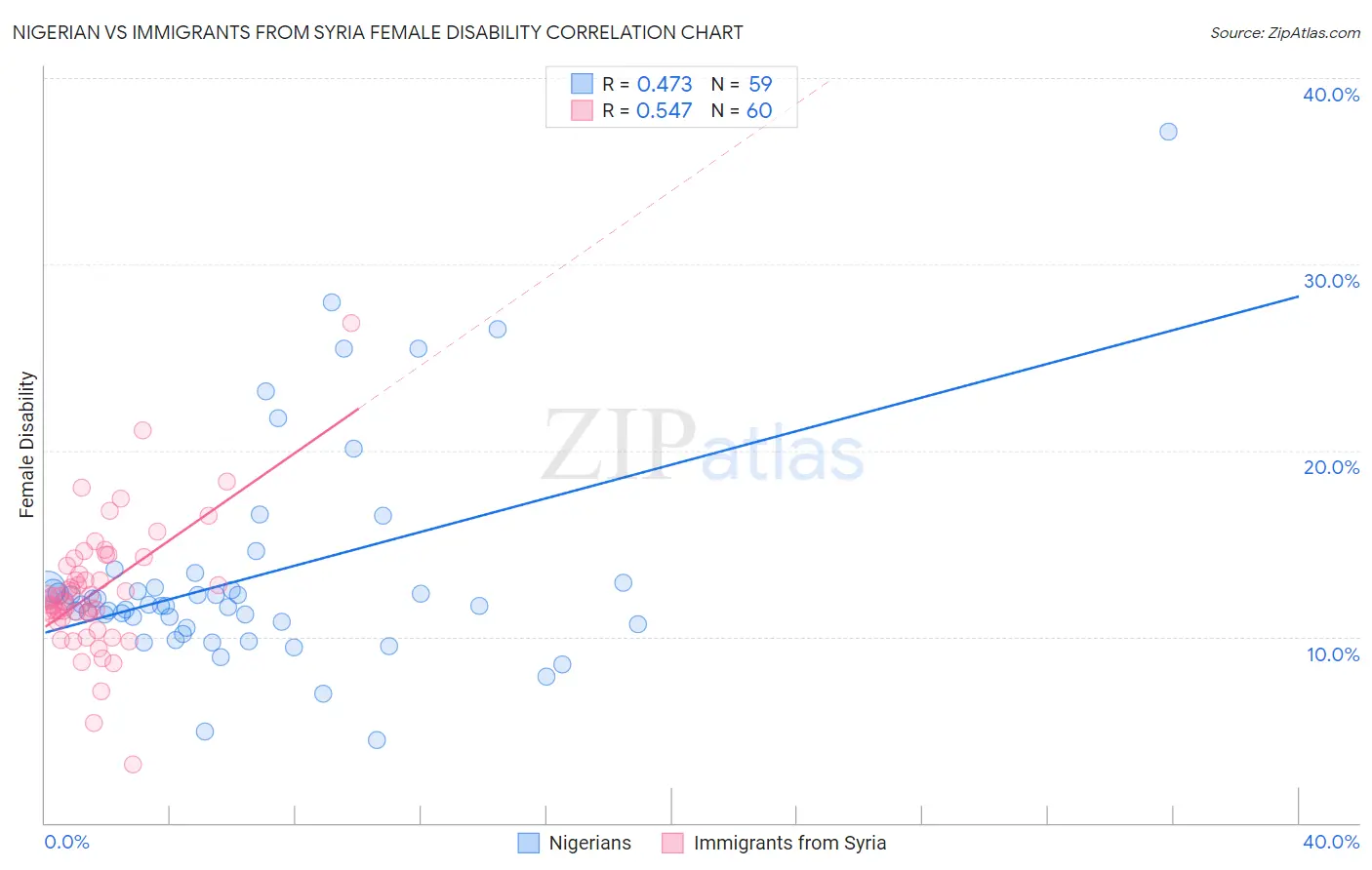Nigerian vs Immigrants from Syria Female Disability
COMPARE
Nigerian
Immigrants from Syria
Female Disability
Female Disability Comparison
Nigerians
Immigrants from Syria
12.0%
FEMALE DISABILITY
84.0/ 100
METRIC RATING
147th/ 347
METRIC RANK
11.9%
FEMALE DISABILITY
94.6/ 100
METRIC RATING
132nd/ 347
METRIC RANK
Nigerian vs Immigrants from Syria Female Disability Correlation Chart
The statistical analysis conducted on geographies consisting of 332,726,873 people shows a moderate positive correlation between the proportion of Nigerians and percentage of females with a disability in the United States with a correlation coefficient (R) of 0.473 and weighted average of 12.0%. Similarly, the statistical analysis conducted on geographies consisting of 174,112,013 people shows a substantial positive correlation between the proportion of Immigrants from Syria and percentage of females with a disability in the United States with a correlation coefficient (R) of 0.547 and weighted average of 11.9%, a difference of 1.2%.

Female Disability Correlation Summary
| Measurement | Nigerian | Immigrants from Syria |
| Minimum | 4.4% | 3.1% |
| Maximum | 37.1% | 26.8% |
| Range | 32.7% | 23.7% |
| Mean | 13.2% | 12.5% |
| Median | 11.7% | 12.0% |
| Interquartile 25% (IQ1) | 10.6% | 11.1% |
| Interquartile 75% (IQ3) | 12.7% | 14.0% |
| Interquartile Range (IQR) | 2.0% | 2.9% |
| Standard Deviation (Sample) | 5.8% | 3.5% |
| Standard Deviation (Population) | 5.7% | 3.5% |
Demographics Similar to Nigerians and Immigrants from Syria by Female Disability
In terms of female disability, the demographic groups most similar to Nigerians are Pakistani (12.0%, a difference of 0.040%), Immigrants from Kenya (12.0%, a difference of 0.070%), Greek (12.0%, a difference of 0.14%), Immigrants from Austria (12.0%, a difference of 0.30%), and Estonian (12.0%, a difference of 0.30%). Similarly, the demographic groups most similar to Immigrants from Syria are Kenyan (11.9%, a difference of 0.010%), Immigrants from Nicaragua (11.9%, a difference of 0.010%), Central American (11.9%, a difference of 0.080%), Arab (11.9%, a difference of 0.10%), and Ugandan (11.9%, a difference of 0.10%).
| Demographics | Rating | Rank | Female Disability |
| Macedonians | 95.5 /100 | #129 | Exceptional 11.8% |
| Nicaraguans | 95.2 /100 | #130 | Exceptional 11.9% |
| Arabs | 95.1 /100 | #131 | Exceptional 11.9% |
| Immigrants | Syria | 94.6 /100 | #132 | Exceptional 11.9% |
| Kenyans | 94.5 /100 | #133 | Exceptional 11.9% |
| Immigrants | Nicaragua | 94.5 /100 | #134 | Exceptional 11.9% |
| Central Americans | 94.2 /100 | #135 | Exceptional 11.9% |
| Ugandans | 94.0 /100 | #136 | Exceptional 11.9% |
| Immigrants | Norway | 93.8 /100 | #137 | Exceptional 11.9% |
| Ecuadorians | 93.4 /100 | #138 | Exceptional 11.9% |
| Immigrants | Hungary | 92.8 /100 | #139 | Exceptional 11.9% |
| Romanians | 91.6 /100 | #140 | Exceptional 11.9% |
| Immigrants | Ecuador | 91.5 /100 | #141 | Exceptional 11.9% |
| Immigrants | Africa | 90.0 /100 | #142 | Excellent 11.9% |
| Immigrants | Sudan | 89.6 /100 | #143 | Excellent 11.9% |
| Immigrants | Austria | 87.9 /100 | #144 | Excellent 12.0% |
| Estonians | 87.8 /100 | #145 | Excellent 12.0% |
| Pakistanis | 84.6 /100 | #146 | Excellent 12.0% |
| Nigerians | 84.0 /100 | #147 | Excellent 12.0% |
| Immigrants | Kenya | 83.1 /100 | #148 | Excellent 12.0% |
| Greeks | 82.0 /100 | #149 | Excellent 12.0% |